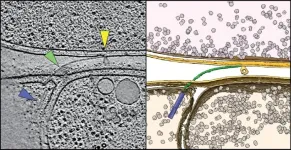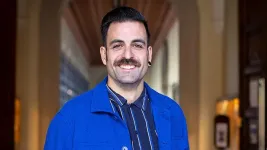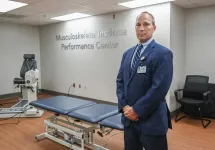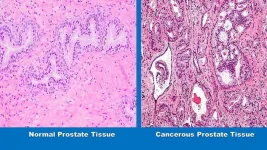(Press-News.org) Countless bacteria call the vastness of the oceans home, and they all face the same problem: the nutrients they need to grow and multiply are scarce and unevenly distributed in the waters around them. In some spots they are present in abundance, but in many places they are sorely lacking. This has led a few bacteria to develop into efficient hunters to tap into new sources of sustenance in the form of other microorganisms.
Although this strategy is very successful, researchers have so far found only a few predatory bacterial species. One is the soil bacterium Myxococcus xanthus; another is Vampirococcus, which sucks its prey dry like a vampire.
In a new study, researchers at ETH Zurich led by Martin Pilhofer, Professor at the Department of Biology, along with his colleagues Yun-Wei Lien and Gregor Weiss, have now presented another of these rare bacterial predators: the filamentous marine bacterium Aureispira.
Among the molecular structures that the researchers have identified in Aureispira are ones that resemble grappling hooks and serve a similar purpose. The bacterium also has a kind of bolt gun that it uses to kill its prey.
Like a pirate ship in search of a potential victim, Aureispira swiftly glides over solid surfaces towards its prey, such as Vibrio bacteria. If the attacker is itself free-floating in water, it waits for its prey to approach. As soon as there is close contact, the grappling hooks become entangled with the victim’s flagella, and it can no longer escape.
Within seconds, Aureispira fires its on-board cannons to punch holes in the Vibrio bacterium’s membrane. In collaboration with the laboratory of ETH Professor Roman Stocker, the researchers were able to show that the cell components that leak out of the victim are quickly taken up by the predator as food. “The whole scene resembles a pirate raid on another ship,” Pilhofer says with a grin.
It’s only when the nutrient concentration in its environment is low that Aureispira becomes predatory. As long as the supply of nutrients is sufficient, the pirate bacterium refrains from catching prey and stands down its arsenal of weapons. However, putting the bacterium on a diet awakens its desire to hunt and causes the cell to rebuild the cannons and grappling hooks. Scientists call this selectively predatory lifestyle ixotrophy. Together with Martin Polz's group at the University of Vienna, the researchers were also able to find evidence that this predatory lifestyle does not only occur in the laboratory but actually in marine samples.
New imaging reveals details
The researchers used several imaging techniques, including light microscopy and cryo-electron microscopy, to understand the function and molecular structure of the grappling hooks and cannons.
This method made it possible to preserve and analyse molecular structures free of artefacts and in their cellular context. With an enhanced version of the method, it’s even possible to determine the molecular structure of the proteins that make up the bacterium’s weapons. “All of these imaging techniques are available at ETH Zurich’s ScopeM competence centre, which made this study possible in the first place,” Weiss says.
What are the findings good for? “First and foremost, this is basic research driven by our curiosity,” Pilhofer says. He and his colleague Weiss have been working for ten years to elucidate contractile injection systems – the name given to the pirate bacteria’s on-board cannons.
In other predatory bacteria, contractile injection systems are often also loaded with toxins to kill the prey immediately. It’s conceivable that such bacterial bolt guns could be loaded with active ingredients for injection into individual cells with the help of a molecular machine.
Certain predatory bacteria are known to prey on cyanobacteria, or blue-green algae. That means they could be used to combat algal blooms or to stop mass propagation of Vibrio bacteria. “These bacterial predators are very efficient at what they do,” Weiss says.
END
Catching prey with grappling hooks and cannons
2024-10-17
ELSE PRESS RELEASES FROM THIS DATE:
Effects of chemical mixtures: Neurotoxic effects add up
2024-10-17
"In our everyday lives, we are exposed to a wide variety of chemicals that are distributed and accumulate in our bodies. These are highly complex mixtures that can affect bodily functions and our health," says Prof Beate Escher, Head of the UFZ Department of Cell Toxicology and Professor at the University of Tübingen. "It is known from environmental and water studies that the effects of chemicals add up when they occur in low concentrations in complex mixtures. Whether this is also the case in the human body has not yet been sufficiently investigated - this is precisely where our study comes in."
The extensive research work was based on over 600 blood samples from ...
Mpox in Africa was neglected during the previous outbreak, and requires urgent action and investment by leaders now to prevent global spread
2024-10-17
Mpox in Africa was neglected during the previous outbreak, and requires urgent action and investment by leaders now to prevent global spread, claim experts from The Independent Panel for Pandemic Preparedness and Response, ex-NZ Prime Minister Helen Clark, former Liberian President and Nobel Peace Prize winner Ellen Johnson Sirleaf, and other global health specialists.
####
Article URL: https://journals.plos.org/globalpublichealth/article?id=10.1371/journal.pgph.0003714
Article Title: Mpox: Neglect has led to a more dangerous virus now spreading across borders, harming and killing people. Leaders must take action to stop mpox now
Author Countries: ...
A new era of treating neurological diseases at the blood-brain-immune interface
2024-10-17
SAN FRANCISCO—The question of what causes complex neurological diseases such as Alzheimer’s or multiple sclerosis continues to confound scientists and doctors, with the unknowns standing in the way of early diagnoses and effective treatments.
Even among identical twins who share the same genetic risk factors, one may develop a particular neurological disease while the other does not.
That’s because unlike diseases such as cystic fibrosis or sickle-cell anemia, which are caused by a single gene, most neurological disorders are associated with many—sometimes hundreds—of rare genetic variants. ...
Astronomers detect ancient lonely quasars with murky origins
2024-10-17
A quasar is the extremely bright core of a galaxy that hosts an active supermassive black hole at its center. As the black hole draws in surrounding gas and dust, it blasts out an enormous amount of energy, making quasars some of the brightest objects in the universe. Quasars have been observed as early as a few hundred million years after the Big Bang, and it’s been a mystery as to how these objects could have grown so bright and massive in such a short amount of cosmic time.
Scientists have proposed that the earliest quasars sprang from overly dense ...
New study highlights the dangers of handheld cellphone use among teen drivers
2024-10-17
PHILADELPHIA (October 17, 2024) – A new study, conducted by a group of researchers led by Penn Nursing and Perelman School of Medicine and funded by the Centers for Disease Control, found a strong association between handheld cellphone use and risky driving behaviors among newly licensed teen drivers. The study, published online first in JAMA Open, used a smartphone telematics application to track the driving habits of hundreds of teens and identify potential safety risks.
The investigation found that teens who used their cellphones while driving were significantly more likely to engage in risky driving behaviors, such as hard braking and rapid acceleration. These behaviors can ...
Part of the GBHSH community in Spain uses doxycycline to prevent sexually transmitted diseases
2024-10-17
The increasing incidence of sexually transmitted bacterial infections (STIs) is a major public health problem worldwide. Currently, among the therapies being studied is the use of the antibiotic doxycycline as a method of post-exposure prophylaxis after unprotected sex — known as DoxyPEP. Now, the University of Barcelona and the NGO Stop have carried out the first study in Spain on the use of DoxyPEP as a preventive strategy among the gay, bisexual and other men who have sex with men (GBHSH) community in Spain.
“The results suggest that, although medical and scientific associations rarely endorse the community use of DoxyPEP as a prevention strategy, ...
Researchers at Wake Forest University School of Medicine receive $4.5 million grant from Department of Defense to study neck injuries
2024-10-17
CHARLOTTE, N.C. – Oct. 17, 2024 – Researchers at Wake Forest University School of Medicine have received a three-year, $4.5 million grant from the Department of Defense to study cervical spine injuries in military personnel.
Musculoskeletal injuries, such as those that occur to the cervical spine (neck), are problematic for military personnel. This is especially true for military personnel who must perform missions in demanding environments with head-supported mass. This head-supported mass includes the baseline protective helmet, communications, specialized night vision technology and other attachments.
“These injuries can lead to a significant number of lost-duty ...
Study suggests a healthy diet may help keep low grade prostate cancer from progressing to more dangerous states during active surveillance
2024-10-17
In a peer-reviewed study believed to be the first of its kind published, a research team led by Johns Hopkins Medicine provides scientific evidence that a healthy diet may reduce the chance of low risk prostate cancer progressing to a more aggressive state in men undergoing active surveillance — a clinical option in which men with lower risk cancer are carefully monitored for progression in lieu of treatments that could have undesired side effects or complications.
The findings are reported today in the journal JAMA Oncology.
“Many men diagnosed with low grade prostate cancer are interested in changes they can ...
Center for Genomic Diagnostics receives first USDA grant
2024-10-17
Foreign animal diseases are a global threat to swine production with the potential for detrimental economic implications. Recently, researchers at the University of Illinois Urbana-Champaign received a three-year grant of $650,000 from the U.S. Department of Agriculture to develop sensitive, rapid, low-cost, and portable point-of-use biosensors to improve on-farm detection and surveillance of African swine fever virus.
ASFV is a large DNA virus that infects swine and can result in a lethal hemorrhagic fever, spread rapidly to neighboring pigs, and cause excessive morbidity ...
The National Tax Journal is pleased to announce the recipients of the 2024 Musgrave Prize and the 2024 Referee Award
2024-10-17
The National Tax Journal is pleased to announce the recipients of the 2024 Musgrave Prize and the 2024 Referee Award.
The Richard A. Musgrave Prize was created in 1999 and is presented each year to the author(s) of the best article published in the National Tax Journal. The award is a tribute to Richard Musgrave, whose work throughout his luminous career was characterized by a powerful blend of analytical clarity, insight drawn from the historical record, and respect for the importance of administrative issues. With this award, the National Tax Association recognizes his many contributions to public policy theory, research, and practice.
This year, ...









